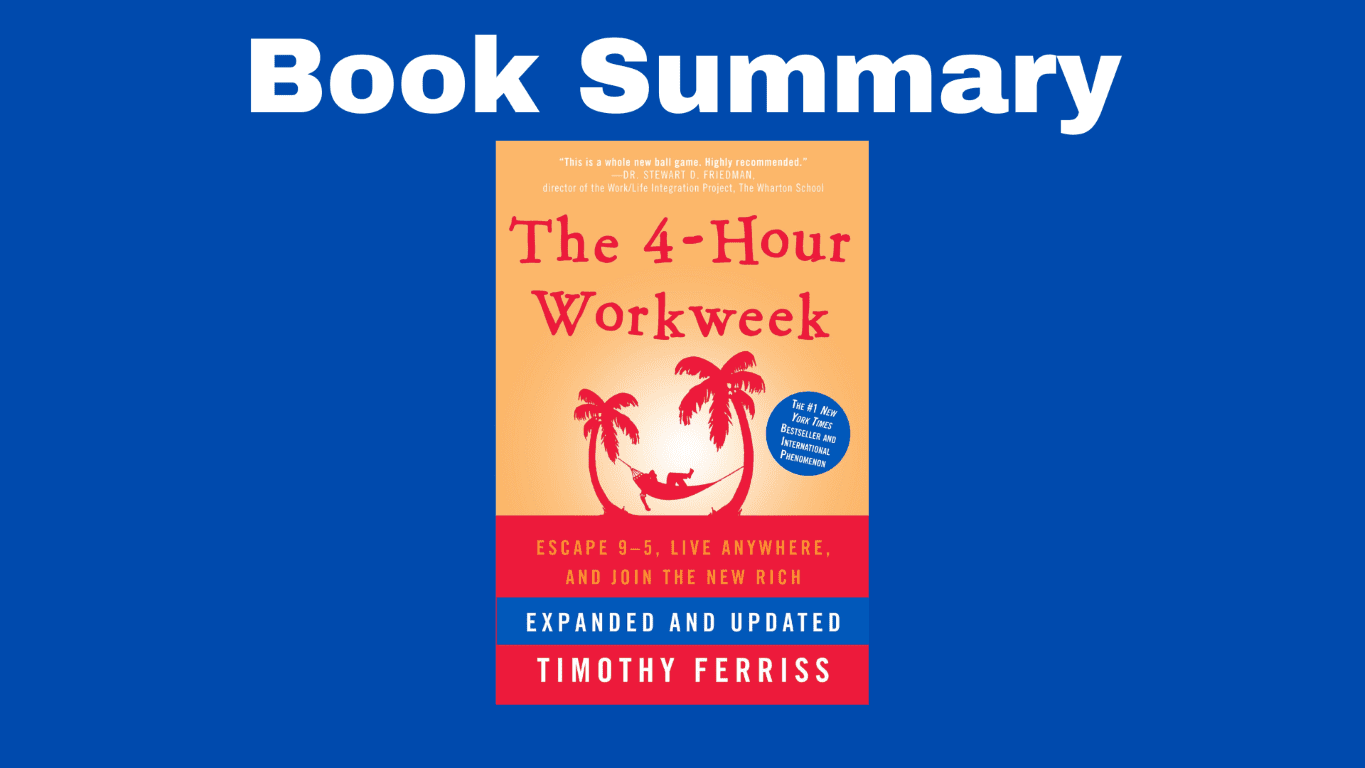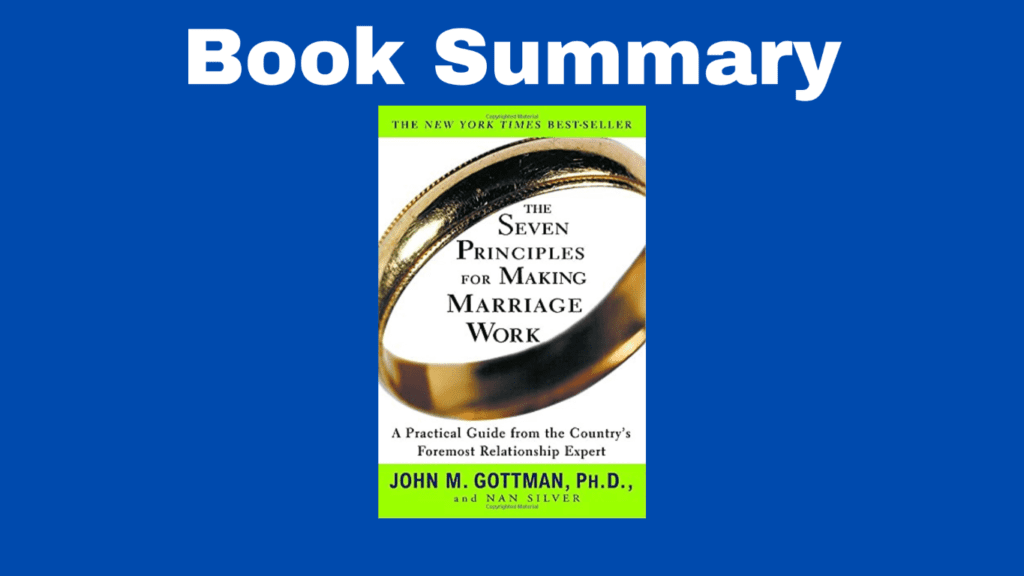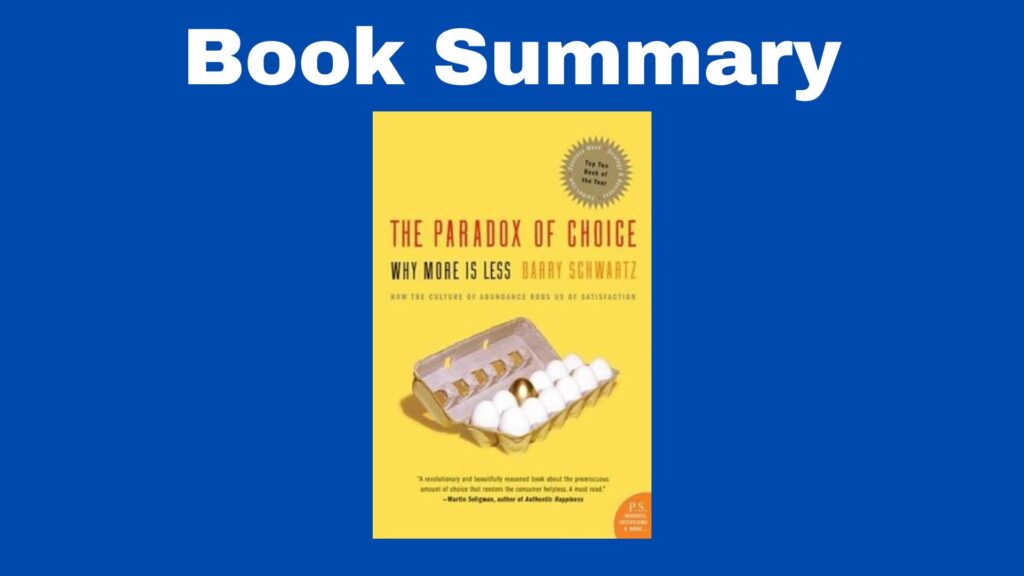The Book in Three Sentences
In this summary of The 4-Hour Workweek, Timothy Ferriss explains everything he’s learned from the New Rich, a movement that uses time and mobility as currencies to create a luxurious life now rather than later. The numerous lessons in this book range from outsourcing your life to a virtual assistant to traveling around the world without quitting your job. The 4-Hour Work Week is about living more and working less.
The 4-Hour Workweek Summary
First and Foremost
The New Rich subculture or NR abandons the usual life plan and creates luxury lifestyles using time and mobility. This is called Lifestyle Design or LD, for short. Although they think they do, most people don’t want to be rich, they just want to experience what they believe millions can buy.
To become a member of the New Rich follow the DEAL acronym:
- D stands for definition and this explains the fundamentals.
- E stands for elimination, so ignore the unimportant.
- A stands for automation and this explains outsourcing.
- L stands for liberation where you’re no longer confined to living in one place.
Step I: D is for Definition
Chapter 1 – Cautions and Comparisons: How to Burn $1,000,000 a Night
What separates the New Rich from the Deferrers? Deferrers save it all for the end, but they eventually find out that life has passed them by.
According to the author, the “freedom multiplier” is money multiplied in practical value depending on the number of Ws you control in your life: what you do, when you do it, where you do it, and with whom you do it. According to Ferriss, the ability to choose is real power.
Chapter 2 – Rules that Change the Rules: Everything Popular is Wrong
Don’t follow a model that doesn’t work.
- Retirement is worst-case scenario insurance. Retirements should be a reservoir of capital in case you need to survive. Retirement as a goal is flawed because it assumes you dislike what you do for most of your life. Most people won’t be able to support themselves on retirement alone and you’ll get bored and start a new project.
- Interest and energy are cyclical. You can’t work all the time, so you should work only when you’re most effective.
- Less is not laziness. Doing less meaningless work means you can focus on what matters most. You should be productive, not busy.
- The timing is never right. For important things in life, conditions are never perfect.
- Ask for forgiveness, not permission. Try different things as long as it doesn’t ruin people around you. If you make a mistake, say sorry and move on.
- Emphasize strengths, don’t fix weaknesses. Accept the fact that you won’t be perfect at everything. Instead of fixing all of your weaknesses, focus on your strengths.
- Things in excess become their opposite. Most endeavors and possessions can be a problem if you have too many of them.
- Money alone is not the solution. Don’t use money as an excuse not to do something. The problem isn’t that you need more money, the problem is more than money.
- Relative income is more important than absolute income. Absolute income takes into account a single variable which is money. Relative income takes into account two variables: money and time.
- Distress is bad, eustress is good. Not all stress is bad, so don’t aim to remove all stress from your life. Eustress is the concept that there’s a kind of stress that’s both healthful and stimulating.
Chapter 3 – Dodging Bullets: Fear-Setting and Escaping Paralysis
When given the option to do something or not to do something, most people choose the latter. Most people would rather be unhappy than face uncertainty. Evaluate the worst-case scenario and force yourself to think if that situation is as bad as you think. Sometimes the worst isn’t that bad, so think about the following:
- Define your nightmare, the absolute worst that could happen if you did what you are considering.
- What steps could you take to repair the damage or get things back on the upswing, even if temporarily?
- What are the outcomes or benefits, both temporary and permanent, of more probable scenarios?
- If you were fired from your job today, what would you do to get things under financial control?
- What are you putting off out of fear?
- What is it costing you – financially, emotionally, and physically – to postpone action?
- What are you waiting for?
Chapter 4 – System Reset: Being Unreasonable and Unambiguous
Achieving unreasonable and unrealistic goals is easier than you think.
To correct the course of your life, get unrealistic. Instead of goal-setting, the author calls this dreamlining because it applies timelines to what other people consider dreams:
- Establish a goal with defined steps
- Set an unrealistic goal
- Living like a millionaire is all about doing interesting things, not owning interesting things.
Here’s a series of steps that you need to complete for dreamlining:
- Create two timelines with up to five things you want to possess, want to do, or want to be.
- For those having trouble coming up with answers, take into account the following questions: what would you do if you had unlimited money? What would make you most excited to wake you up?
- What do you have to do to be something? Turn your intentions into actionable steps, what do I need to do in order to be fluent in Chinese?
- List four dreams that would change your life
- Determine how much those dreams would cost.
- Instead of long-term planning, determine three steps for each of the four dreams in the 6-month timeline and start taking the first step now.
Important actions aren’t comfortable, so train yourself to be comfortable in uncomfortable situations.
Step II: E is for Elimination
Chapter 5 – The End of Time Management: Illusions and Italians
Forget everything you know about time management. Instead of creating “busyness”, accomplish more by doing less.
The difference between being effective and being efficient: effectiveness is doing things that get you closer to your goals and efficiency is about performing a task in the most economical manner possible. What to do is much more important than how you do it, so focus on important tasks.
Vilfredo Pareto was an Italian economist who created Pareto’s law a mathematical formula that established that 80% of the outputs result from 20% of the inputs and was soon applied outside of mathematics.
Both in the business sense and your personal life, the author encourages readers to answer the following questions:
- Which 20% of sources are causing 80% of my problems and unhappiness?
- Which 20% of sources are resulting in 80% of my desired outcomes and happiness?
Eliminate inefficiencies.
Remember to slow down, being busy is a form of laziness. Doing less is the path to productivity.
Parkinson’s law says that a task will increase in importance and complexity in relation to the time given for its completion. With this in mind:
- Use Pareto’s Law to limit tasks to the most important.
- Use Parkinson’s Law to shorten the length of those tasks
Write a to-do list and a not to-do list. Using the aforementioned laws, think about the activities that produce the most results and remove all the others. Think about the people that bring you happiness, and remove all the others. Whatever you do, don’t multitask.
Chapter 6 – The Low-Information Diet: Cultivating Selective Ignorance
Be selectively ignorant. Most information is time-consuming, negative, and irrelevant to your goals.
- Go on a one-week media fast. This involves no newspapers, magazines, audiobooks, or talk radio. Music is allowed. No news websites. No TV except for one hour of pleasure viewing. No books are allowed, except for one hour of fiction reading before bed. No web surfing unless it’s necessary for work. Bond with people instead of consuming, complete your priorities, and block certain websites.
- Ask yourself: “Will I use this information for something immediate and important?”
- Practice the art of nonfinishing for boring and unproductive media. If you start doing something, it doesn’t mean you have to see it all the way through.
Chapter 7 – Interrupting Interruption and the Art of Refusal
Be difficult when it counts.
There are three types of offenders when it comes to interruptions:
- Time wasters: you can ignore them. These include meetings, discussions, phone calls, unimportant emails, and web browsing.
- Time consumers: repetitive tasks that interrupt high-level work. Reading and responding to emails, customer service, and personal errands.
- Empowerment failures: someone needs approval to make something happen. Fixing customer problems, and cash expenditure.
To deal with time wasters, eliminate and deflect.
- Limit email by turning off alerts and then check email once or twice a day at set times. Preferably once at noon and again at 4 pm.
- Screen incoming and limit outgoing calls. Use two phone lines: a non-urgent phone line and an urgent cellular one. The non-urgent one should always go to voice mail and the latter should always be answered.
- Avoid meetings at all costs, especially the ones that don’t have clear objectives. If someone proposes a meeting, tell them to contact you via email or phone instead. Respond to voicemails via email, so that people are concise. Only attend meetings that have an agenda.
- If you can’t prevent a meeting from happening, define the end time. This forces people to be concise and focused.
- Don’t allow casual visitors into your cubicle. Use a “do not disturb” sign, headphones, or ask for a follow-up email.
- Give people an alternative when it comes to meetings. The alternative should be to never have meetings again.
Empowerment failure is being unable to accomplish something without getting permission first. People are smart, so give them a chance to prove it to you. Set some rules, such as limiting access to your time, constantly challenging the status quo, forcing people to define their requests before approaching you, and batching unimportant tasks so that they don’t interrupt important ones.
Step III: A is for Automation
Chapter 8 – Outsourcing Life: Off-Loading the Rest and a Taste of Geoarbitrage
In this chapter, Ferriss discusses how you can outsource your life to an overseas remote virtual assistant. He essentially created a system to replace himself.
Eliminate before you delegate. Never automate something that can be eliminated, and never delegate something that can be automated or streamlined.
There are two rules for delegating:
- Delegated tasks have to be time-consuming and well-defined.
- Have fun with it.
In technology, there’s something called the single point of failure, which is when everything depends on one fragile item. So instead of having a single virtual assistant, hire one with a backup team.
When it comes to virtual assistants:
- Make special requests when hiring one.
- Give precise directions.
- Don’t give them a license to waste time.
- Give them no more than 72 hours to complete a task.
- If you’re giving them too many tasks, set the order of importance.
Chapter 9: Income Autopilot I: Finding the Muse
Aim for an automated business that generates money without taking your time. Since the term business is too broad, the author refers to it as the muse.
Step One: Pick an Affordably Reachable Niche Market
Find your niche, the more specific, the better. To find a profitable niche, answer the following questions:
- Which groups do you belong to, have belonged to, or do you understand? For this, take into account your resume, work experience, habits, hobbies, products or books you own, online and offline subscriptions, and magazines or websites you read on a regular basis.
- Which of the groups you identified have their own magazine? You can consider advertising in them.
Step Two: Brainstorm (Do Not Invest In) Products
Brainstorm using the markets you found. This is what you should take into account.
Don’t confuse the audience, your benefits should be explained in one sentence.
The product you sell should cost between $50 and $200.
- Higher prices mean selling fewer units.
- Higher prices attract lower-maintenance customers
- Higher prices create a higher profit margin.
Your product should take between 3 to 4 weeks to manufacture.
You should be able to explain everything about your product in an online FAQ.
How do you obtain a good business that satisfies customers?
- Resell a product. This is an easy option, but one that’s the least profitable.
- License a product. To do so, you need an inventor, which comes up with the product, and a licensor, who profits from each unit sold. The person interested in manufacturing and selling the product is the licensee and this person gets between 90% and 97% of the profit.
- Create a product. The author recommends information products because their cheap, low-cost, fast to make, and hard to replicate.
Since Ferriss recommends information products, a lot of people might say that they’re not experts. Having expert status depends on how you got your content in the first place. There are three options to consider:
- Create the content yourself by paraphrasing or combining ideas from different books.
- Repurpose content that’s available in the public domain or has no copyright protection.
- Compensate an expert to help you create content.
Chapter 10: Income Autopilot II: Testing the Muse
Step Three: Micro-Test Your Products
To micro-test a product, you use cheap advertisements to see how consumers respond to a product before actually making it. Before the internet, you would pay for small classified ads, but nowadays, you’d use Google Adwords.
Chapter 11 – Income Autopilot III: MBA – Management By Absence
Once you’ve designed, tested, and approved a self-sustaining system, remove yourself from the equation.
Making the wrong decisions can put you out of business.
Serve the customer, but remember that you’re not catering to their every need, so as long as you’re providing a great product at a great price that solves problems in the fastest way possible, that’s where your job ends. Offer fewer options because this translates into more revenue. More options generate more indecision.
As a general rule:
- Offer two options: “basic” and “premium”.
- Offer two shipping options: a fast method and a premium method.
- Do not offer overnight shipping.
- Eliminate phone orders.
- Don’t offer international shipping
Avoid bad customers.
Step IV: L is for Liberation
Chapter 12 – Disappearing Act: How to Escape the Office
The old rich are well-established in one place. The New Rich use mobility as a currency that enables them to work from anywhere in the world. Regular employees can live like this too, but they need to demonstrate the benefits of working remotely and make it expensive to refuse your request for it.
- Step 1: Increase Investment. Encourage the company you work for to invest in you so that the loss is greater if you quit.
- Step 2: Prove Increased Output Offsite. Call in sick to prove that working remotely actually works. Double your work output and keep records of your accomplishments. Install remote access software so that you can keep using your computer from home.
- Step 3: Prepare the Quantifiable Business Benefit. Create a bullet-point list of achievements. Show how working remotely is a good business decision.
- Step 4: Propose a Revocable Trial Period. Propose a one-day-per-week remote work trial period for two weeks.
- Step 5: Expand Remote Time. Show that working remotely is extremely productive. Set up a meeting to discuss the results with your boss and prepared a page detailing everything you completed in this period in the form of a bullet list. Suggest working from home four days a week, but be prepared to get three.
Chapter 13 – Beyond Repair: Killing Your Job
If you’re unsatisfied with your life now with the consequences of bad decisions you made years ago, you should still consider making good decisions now. Being able to quit something that doesn’t work, even your job is one of the traits of winners. Most people have the same fears when it comes to quitting their jobs:
- Quitting is permanent.
Actually, a change of direction in life is reversible most of the time.
- I won’t be able to pay the bills.
The objective is to have a new job before quitting.
- Health insurance and retirement accounts disappear if I quit.
Fixing this issue isn’t just possible, it actually takes a few minutes and you can do it over the phone.
- It will ruin my resume.
The idea is not to quit and do nothing, the idea is to quit and use your precious time for something interesting you can add to your resume later on.
Chapter 14 – Mini-Retirements: Embracing the Mobile Lifestyle
There are several excuses not to travel, but they’re just excuses. Before you’re ready to travel though, you should get rid of the possessions you don’t use, need, or want. The clutter causes indecision and distractions, preventing you from being happy, so sell, donate, or get rid of those things. You’ll be happier, have some extra cash, have more space in your house, and you won’t feel attached to items that ultimately make you unhappy. This will make it easier for you to travel, but remember to take the essentials with you.
The author encourages readers to take the absolute minimum with them and allocate $100 to $300 to buy toiletries or extra clothing items. According to Ferriss, this is what you should pack:
- One week of clothing
- Backup copies of all important documents.
- Debit cards, credit cards, and $200 worth of small bills in local currency.
- A lock for securing luggage.
- Electronic dictionaries or small grammar guides.
- A travel guide.
Don’t take a laptop with you unless you’re a writer.
First, eliminate. Get used to minimalism by taking some decisions about your belongings. Pareto’s Law says that we use 20% of things, 80% of the time. Eliminate the 80% of things you don’t use. Remember that you can always repurchase something if you miss it too much. The belongings that create stress in your life should be the ones eliminated first.
Second, automate. Set up auto payment.
Finally, these are all things that need to be taken care of before leaving for your destination: have all mail forwarded to someone you trust, get all the vaccines recommended for the region you’re traveling to, set up remote-access software and test it, scan important documents, set up a voice mail, find an apartment in your destination, get medical insurance, work on your schedule, move the remaining things into storage, take care of your car before leaving.
Chapter 15 – Filling the Void: Adding Life After Substracting Work
When you find yourself with a lot of free time and more time and money than you ever dreamed of, you’ll face a crisis. There’s a reason why most people put up with their jobs even if they hate them, socializing with other people kept us there in the first place.
This will lead to some existential questions and even depression. Remember that if you can’t define it or act upon it, you should forget it.
One of the reasons behind traveling and relocating is to learn more. Ferriss prefers to focus on learning another language and a physical skill for each country he visits. He also suggests helping others.
Chapter 16: The Top 13 New Rich Mistakes
- Losing sight of dreams and falling into work for work’s sake.
- Micromanaging and emailing to fill time.
- Handling problems your outsources or co-workers can handle.
- Helping outsourcers or co-workers with the same problem more than once, or with noncrisis problems.
- Chasing customers, particularly unqualified or international prospects, when you have sufficient cash flow to finance your nonfinancial pursuits.
- Answering email that will not result in a sale or that can be answered by a FAQ or auto-responder
- Working where you live, sleep, or should relax.
- Not performing a thorough 80/20 analysis every two to four weeks for your business and personal life.
- Striving for endless perfection rather than great or simply good enough, whether in your personal or professional life.
- Blowing minutiae and small problems out of proportion as an excuse to work.
- Making non-time-sensitive issues urgent in order to justify work.
- Viewing one product, job, or project as the end-all and be-all of your existence.
- Ignoring the social rewards of life.
The Last Chapter
The book’s final chapter focuses on a poem titled “Slow Dance” originally written by child psychologist David L. Weatherford.
Further Reading
If you liked this summary of The 4-Hour Workweek, you might also like:




